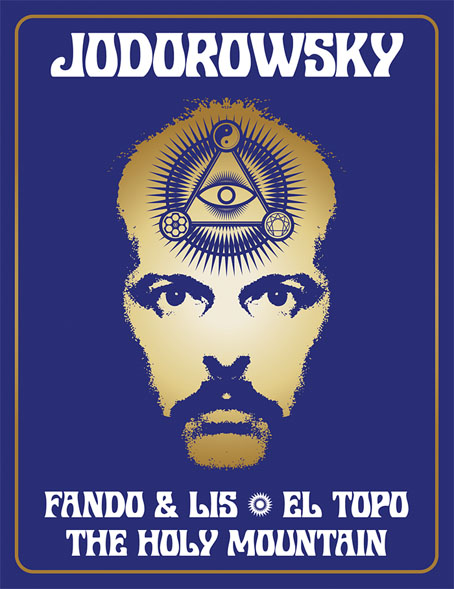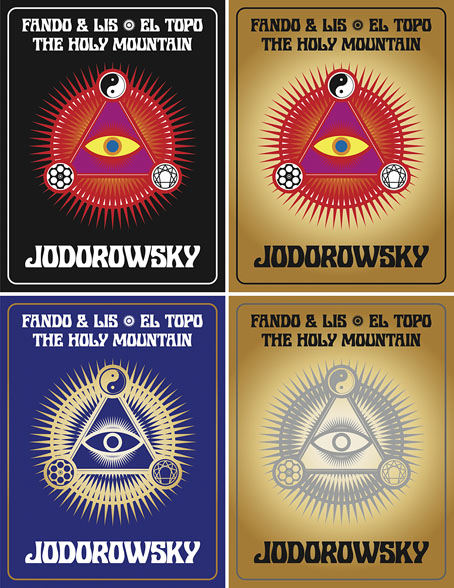The first three feature films by Alejandro Jodorowsky—Fando y Lis, El Topo and The Holy Mountain—are released this week on Region B blu-ray by Arrow Video, but the box they’re packaged in won’t look like any of the designs shown here. It was almost three years ago that Arrow asked me to create something for this box set, but backstage wrangles meant the project moved out of my hands in the early stages. This was a great disappointment since Jodorowsky’s interests and aesthetics align with my own much more than many other directors whose work has been released by Arrow. And having written the notes for the Arrow release of Henri-Georges Clouzot’s The Mystery of Picasso, I was looking forward to working with the company again.
In preparation for the work I rewatched almost all of Jodorowsky’s films (I still haven’t seen Tusk or The Rainbow Thief), then drew up a detailed proposal with sketches, something I seldom do for commissions. Arrow releases all have double-sided inserts in the boxes that hold the discs, one side of which shows a poster design from the film’s original release, the other a new design. My idea for the new art was to connect the three films using Tarot-like iconography (the director is a Tarot scholar, among other things), with each film also being assigned a symbol of some kind. The Surrealist fable of Fando y Lis lacks any suitable graphics so for this I chose a yin and yang symbol to represent the film’s opposed-yet-connected brother and sister characters; El Topo was to be represented by a cross-section through a revolver chamber, while the seven characters from The Holy Mountain are represented by the enneagram that Jodorowsky himself wears in the film. All three symbols are connected by the eye-in-a-triangle from El Topo, a symbol that worked while a three-film box was being planned but which wouldn’t have worked for the final release which adds Jodorowsky’s most recent film, Psychomagic, A Healing Art. For the box design I suggested metallic inks (or foils) either as highlights or in other combinations. The font was a further suggestion, Roberta being one of the typefaces of the occult revival of the 1970s. The art for each film didn’t go further than the sketch stage although I was asked to work up the El Topo design into a final piece; I wasn’t very satisfied with the end result so it isn’t posted here. One problem with the extended negotiations was they were taking place at a time when I was extremely busy with other projects, including contracted illustration work for Editorial Alma. There was no contract for the Arrow commission so it had to take second place even though it was the work I most wanted to be concentrating on at the time. Collisions such as these are an occupational hazard when you’re working freelance.
As things turned out the stumbling block wasn’t my art and design suggestions (which Arrow liked) but the parties described in communications as “the rights-holders”. These individuals apparently disliked the Arrow Video aesthetic and wanted something more directly connected with the films, preferably photographic material which is what you now see on the discs and the box art. It should be emphasised that the rights-holders are not the director, whose wishes for the presentation of his work were never part of the discussion. Given the previous activities of the rights-holders we should probably be grateful that the first three films have been reissued at all. For details of Jodorowsky’s difficulties with one rights-holder in particular, see this interview by Jay Babcock.
On the upside (there is one!), the box set is a typically high-quality Arrow release, with new transfers of the films approved by the director. The bonuses include Jodorowsky’s short films (including his explanation of Tarot symbolism), Louis Mouchet’s feature-length documentary, La Constellation Jodorowsky (1994), soundtrack CDs of El Topo and The Holy Mountain, a small poster and set of postcards, and a substantial booklet. In the end the most important thing is that the films are available for home viewing once again, not their exterior decoration.
Previously on { feuilleton }
• Fabulas Panicas by Jodorowsky
• Alejandro Jodorowsky’s Dune
• Jodorowsky on DVD



John, what a shame this project never came to pass – as ever your design concept conjures up something intimately connected to the work, reflecting Jodo’s interests and obsessions – far more profound than the usual still-from-the-film approach. This might have been something truly special and esoteric to adorn the DVD shelf. Your mention of the rights-holder exerting his influence over the set feels ever so familiar when it comes to the knotty distribution history of El Topo and Holy Mountain – I remember a time when both films were so difficult to see, it was only when El Topo debuted on VHS in the late 90’s courtesy of Nouveaux Pictures did I finally see Jodo’s signature film after years of reading about it in the underground press. For this teenager seeing the film was of course a startling experience but I must admit, I’ve grown lukewarm on the film in recent years – not so much the first hour or so, which remains terrific, but I tend to find the final act of the film something of a sub-Fellini slog. Having said that, the last time I did see the film, I had to wonder if Jess Franco took inspiration from the bird-shrieking woman the gunslinger encounters on his quest, for Anne Libert’s similarly shrieking bird woman in Franco’s 1973 film The Erotic Rites of Frankenstein – I like to imagine Franco catching the film in a small Parisian cinema and filing the character away in his feverish brain for later use !
If El Topo has diminished in size for me over time, Santa Sangre has emerged as Jodo’s great masterpiece, and I’d like to give an endorsement to Tusk, Jodo’s much maligned children’s film – the received wisdom would suggest Tusk is without merit (Jodorowsky did after all disown the film), but I feel it sufficiently Jodorowskyesque to warrant a well-deserved rescue from the world of scrappy VHS rips. I wrote a few words on the film back in 2011 and I remain very fond of the film to this day…
Thanks, Wes. Jodorowsky’s right-holders were directly responsible for keeping his films unavailable for so long–something he complained about many times in interviews–so that shows their attitude to art and creativity. I’m fairly sure that Arrow weren’t happy with the situation since these are the only discs on the Arrow Video label (as opposed to Arrow Academy, which has a different look) to use stills instead of new artwork. And Jodorwosky himself has worked for years in comics so he wouldn’t have objected to their art style. For my part, it’s another occupational hazard that the bigger the size of the commission, the more people there are who are liable to interfere with your work.
I think I like Holy Mountain the most of all his films. It has the most striking visuals, and the spiritual quest has a coherence that El Topo lacks. I’ll keep an eye out for Tusk, I’m curious to see it even if he dislikes it. Artists aren’t always the best judge of their own work since they can often dislike a thing for reasons that aren’t visible to the audience.